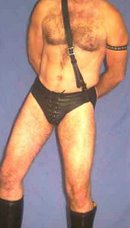
A hero a day
Gay GLBT History Month introduces students to 31 gay rights leaders
REBECCA ARMENDARIZ Friday, October 05, 2007
From Leonardo da Vinci to Leonard Bernstein, organizers of GLBT History Month are urging a new generation to learn more about the contributions of 31 iconic gay figures throughout the month. This year marks the second time Equality Forum has organized the month-long celebration.
Though educators launched the concept in the mid-1990s, it failed to catch on. This time around, however, GLBT History Month has found support from major national organizations. Malcolm Lazin, Equality Forum’s executive director, says that last year, 20 organizations promoted the month on their web sites. This year, 80 colleges — from community institutions to Ivy League schools — have put a link to the project on their home pages.
Other supporters include 12 statewide organizations, 28 community centers and corporations, including Banana Republic and McDonald’s.GLBT History Month aims to educate the public about the importance of gay figures in creating the movement’s history. “As much as our history has been closeted from us, it’s also been closeted from the mainstream,” Lazin said. “[The month] combats a societal homophobia by providing role models in that history.”Equality Forum’s project is available to school-age children.
This year, the organization collaborated with the Gay, Lesbian & Straight Education Network to meet with high school students. As a result of those interactions, Equality Forum has created weekly, multiple-choice challenges based on the biographies and videos for each week’s seven icons. At the end of the month, there will be a Rainbow Challenge based on all 31 role models.“If we do not take the responsibility of teaching our history, no one else will,” Lazin said.
Some of those honored include Gore Vidal, an American author known for his novel “The City and the Pillar”; Susan Sontag, an American essayist and activist; David Hockney, an English artist; Gertrude Stein, an American author and art enthusiast; and Frank Kameny, who, according to Lazin, is the “father of the GLBT civil rights movement.”
State, national and international executive directors of gay rights groups submitted their nominations and Kenji Yoshino, a Yale Law School professor and author of “Covering,” and Rev. Nancy Wilson, moderator of Metropolitan Community Churches (MCC), selected the final 31 icons.
Yoshino says that GLBT History Month is for everyone.“Because GLBT individuals are usually born to heterosexual families, it is not as likely that individuals in the GLBT community will be taught by their families of origin about GLBT history,” Yoshino said. “The organizing principle of ‘a person a day for a month’ permits individuals to learn without being overloaded,” he said.October was chosen to highlight these people, Yoshino said, because it is the beginning of the school year, and it’s more likely that students would be made aware of the project.“Our hope is … that individuals will see one famous figure they know and then keep browsing to see who else we have chosen as their peers,” he said.
The selections are as diverse as Leonardo da Vinci and Angela Davis. Yoshino says, “that sense of oddness … should teach us that the project of gay history is still young. Because our history has just begun to see the light, it’s not surprising that people juxtapose a Renaissance artist and a contemporary activist.”
Frank Kameny is one of those contemporary activists. Rep. Tammy Baldwin (D-Wisc.) names him as one of her own personal heroes. He is widely credited with spearheading the gay civil rights movement, and has been an activist for half a century.“He started that grassroots organizing that has laid a foundation for later change,” Baldwin said.
Baldwin recently wrote a piece titled, “Leaning Toward Justice” as part of the Gay History Project.“Leaning Toward Justice” compares the gay rights movement to the civil rights movement of the 1960s. Baldwin said the project will help remind young readers that while change sometimes seems to come slowly, in a historical context, the movement has actually progressed with surprising speed. To put things in context, Baldwin writes of her own coming out in the 1980s and the energy she put into learning about gay rights leaders and their contributions.“No role model ever told me about the Daughters of Bilitis, the Mattachine Society, or Stonewall; Elaine Noble, Frank Kameny, or any of the courageous leaders who shaped our movement or contributed their art, their science, their sweat and their intellect to this world,” she said.
Kameny says he feels good about being named a hero of gay history. “I think as ideas and projects of this kind come along, provided people do pursue them, we’ll be able to establish our history and our place in history, using the word history in a larger sense. There is an extensive gay history,” Kameny said. He added that he has too many gay heroes to name.
Kameny has played a key role in achieving civil rights for the gay community. His early focus was repealing sodomy laws and removing homosexuality from the American Psychiatric Association’s manual of mental disorders. He is hopeful that with a Democrat in the White House in 2008, that his final goal of repealing the ban on gays in the military will be realized.“More than anything else, not as a specific issue, but simply as a tactic, we just need to get people out and open. I think that’s absolutely necessary,” he said.
Recently, Kameny’s papers and materials from the 1960s were put on display at the Smithsonian. “We would have never believed when we were making those signs in 1965 that they were going to end up actually in the Smithsonian and some of my papers in the Library of Congress … it’s just totally incredible,” he said.
Yea, I have had the privilege of meeting and talking briefly with Frank Kameny, over several years. He is quite a man. A living history of the gay movement.
But like anything else, youth is wasted on the young. Who needs the most education today are gay youth. They think, somehow, that they are the first queers to face anything. But hey, there are many of us, survivors, if you will, that have lived open lives, have lived actively sexually, and have blazed the trail for the twinks of today.
Buddy body bonding never goes out of style, and will always have its place in the gay male world. Fortunately, in this case, one size does fit all. Do some exploring on your own, hug a bud and have a fantastic Columbus Day weekend.











1 comment:
Hello, you have a wonderful blog, but I can't find your email address, can you please contact me at linkexchange@edenfantasys.com? I have something to discuss with you
Regards, Chris
(Please can you delete this comment after your decision?)
Post a Comment